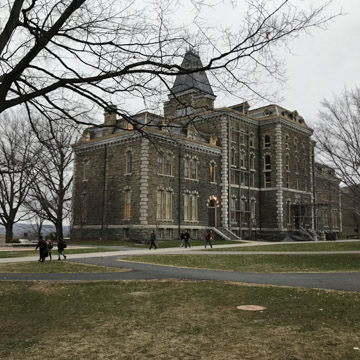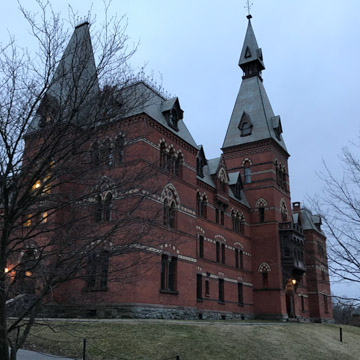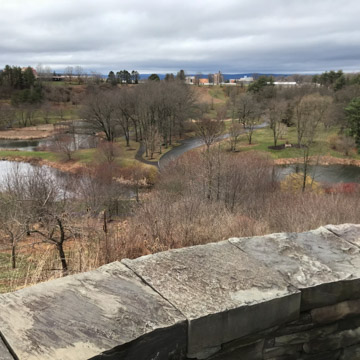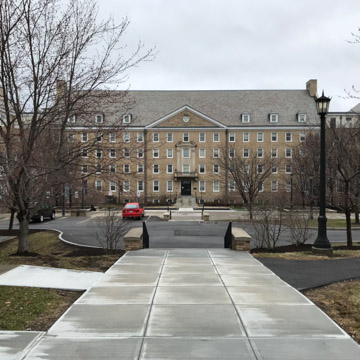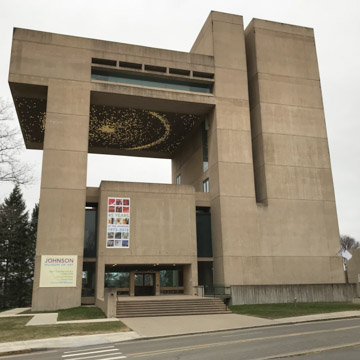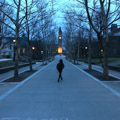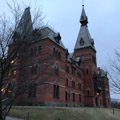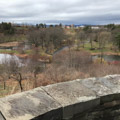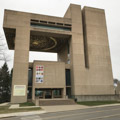Perched on a hill above Ithaca, New York, and straddling the Fall River and Cascadilla River gorges, Cornell University’s campus is widely considered one of the nation’s most spectacular. This is in part due to its architectural heritage: with ten buildings individually listed on the National Register of Historic Places, several local landmarks, and three neighborhoods with university-owned properties listed as National Register historic districts, Cornell features a collection of buildings spanning every imaginable American style since the late nineteenth century. The campus built environment is particularly notable for the High Victorian Gothic buildings of Sage College, the ironwork of White Library, and the massive central Arts Quadrangle with its stylized late-nineteenth-century Romanesque buildings.
Cornell University is also notable for its landscape—and its land. Comprising nearly one million acres of formerly Indigenous lands in the West and Midwest taken by cession or seizure—the most of any state—Cornell is one of three land-grant institutions in the nation to feature a mix of private and public financing (three of its seven undergraduate colleges and its graduate College of Veterinary Medicine are funded through state appropriations). Founded by Ezra Cornell in 1865 for the purposes of placing the “benefits of higher education at the disposal of the industrial and productive classes of society,” the university has long cultivated the “practical” fields of agriculture, mechanical arts, and domestic science, and treated them with a respect and rigor equal to any field in the humanities. “I would found an institution,” Cornell famously wrote in 1868, “where any person could find instruction in any study.”
Home economics was one such subject of study. Today absorbed into fields that are part of the College of Human Ecology, instruction in Home Economics at Cornell was among the first in the country at a land-grant institution. Established initially by faculty members Martha Van Rensselaer and Flora Rose to advance opportunities for women in rural communities, the effects of their instruction continues to be advanced by students and faculty in Martha Van Rensselaer Hall (1933, William Haugaard). The remote, rural university (Cornell’s main campus in Ithaca is located in the near-geographic center of the state, more than an hour from any large city) was also one of the nation’s first institutions to offer a co-educational, secular education—land grant or otherwise. In these and other respects, Cornell’s establishment and growth are important stories on a national level.
Cornell’s main campus is elevated above the town of Ithaca, but it has long been tied to the community and the region in ways that are still visible on the land. This connection was apparent from the beginning, when Ezra Cornell wished to ensure that the institution would simultaneously allow students and faculty an expansive view of the town and Cayuga Lake Valley below while permitting townspeople with a view of the campus above. Perhaps the university’s most evident connections to the landscape are the Cornell Botanic Gardens and the F. R. Newman Arboretum: an approximately 4,000-acre natural area to the northeast of campus, originally part of Ezra Cornell’s farm, established for the study of forestry, horticulture, and the natural sciences. The vast, open space of the Arts Quadrangle, along with the locally quarried bluestone that clads the “Stone Row” of Morrill, McGraw, and White Halls (among the institution’s earliest buildings) also makes these connections; their link to the town, meanwhile, is apparent in the westward-facing orientation of their original facades. And the gorges of Fall Creek, which drop precipitously between the northern and southern edges of the main campus on their way to Cayuga Lake, provide extraordinary natural features. The architecture would seem but a backdrop to this dramatic landscape.
Yet the architecture of Cornell University would not be accurately characterized as an agglomeration of buildings merely deferent to the landscape. Though Ezra Cornell favored an architecture of utility, Andrew Dickson White, the institution’s first president, admired the ordered beauty of quadrangles he recalled from his undergraduate years at Yale University and sought for the university a dignified, symbolic architecture suitable for the land-grant institution in New York State. To this end, campus development proceeded in a relatively organized fashion, with buildings arrayed around enclosures (an expansive Agricultural Quadrangle characterizes the northeastern side of the main campus for the College of Agriculture and Life Sciences) and clusters of buildings generally matching one another in material and scale. Early red brick buildings that seem to best represent White’s vision of a dignified campus were designed by William Henry Miller and Charles Babcock in the 1870s and include three High Victorian Gothic buildings located just south of the Arts Quadrangle: the Andrew Dickson White House, Sage Hall, and the secular Sage Chapel. Though not highly ornate, the 173-foot freestanding Romanesque McGraw Tower to the north, designed by Miller and completed in 1891, is the grand sentinel of campus and third-tallest university clock tower in the United States.
The tallest building at Cornell University, however, is Bradfield Hall: a brick-clad tower designed by Ulrich Franzen for the Agronomy Department and completed some seventy-eight years later in 1969. At 166 feet, Bradfield Hall is also the tallest building in Tomkins County and dominates the eastern edge of campus. It is notable, if not notorious, for its lack of windows on ten of the eleven stories of its climate-controlled interior—a design feature deemed necessary for the research conducted inside. Such functionally oriented buildings were characteristic of much of Cornell’s development in the post–World War II years. Yet with the exception of the Herbert F. Johnson Museum of Art, designed by I.M. Pei at the northwestern edge of the Arts Quadrangle and completed in 1973, most of the postwar development occurred away from the central campus, including a series of new buildings for the College of Engineering. Few of them, however, ultimately marred the institution’s connection to the landscape. Even the Johnson Museum, despite its blocky appearance, retains a sense of openness by virtue of the large, square opening created by a cantilevered bridge at the sixth floor. The bridge contains an elevated conference room that spans the museum’s two principal exterior volumes.
Other buildings of architectural note at Cornell, not all of which are affiliated with those colleges receiving state support, include Goldwin Smith Hall (1904, Carrère and Hastings), the Schwartz Center for the Performing Arts (1989, James Stirling), and Milstein Hall (2011, Office of Metropolitan Architecture)—the first building for the College of Architecture, Art, and Planning in over a century.
For the most part, however, the Cornell University campus is not characterized by single works of architectural grandeur. Given its origins in the extraordinary profits made from what had been 6,716 parcels of Indigenous land taken from all over the Midwest and West, Cornell might more effectively be read by examining the relationship between buildings and landscape and asking whether that relationship represents the mission of a wide-ranging education in every field—no matter its physical openness. Regardless of Cornell’s limited acceptance rate, which makes this mostly private, Ivy League university one of the most selective “land-grant” institutions in the country, with so much appropriation of Indigenous land, one might also question whether that education was ever truly available to all—or whether it ever will be. Yet this same question might be asked of every land-grant institution in the United States. Only a few of them can boast of such a spectacular natural landscape and even fewer can point to the enduring connections between the built and natural environments to such a degree.
References
Gumprecht, Blake. The American College Town. Amherst: University of Massachusetts Press, 2008.
Lee, Robert, and Tristan Ahtone. “Land-Grab Universities: Expropriated Indigenous Land is the Foundation of the Land-Grant University System.” High Country News (Paonia, CO), March 30, 2020.
Parsons, Kermit Carlyle. The Cornell Campus: A History of Its Planning and Development. Ithaca: Cornell University Press, 1968.
Turner, Paul Venable. Campus: An American Planning Tradition. Cambridge: MIT Press, 1984.


